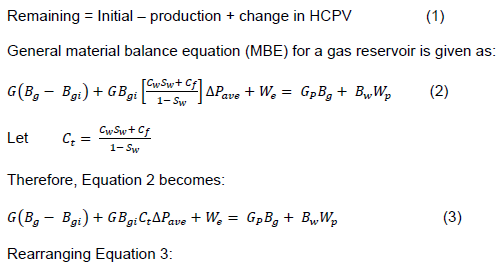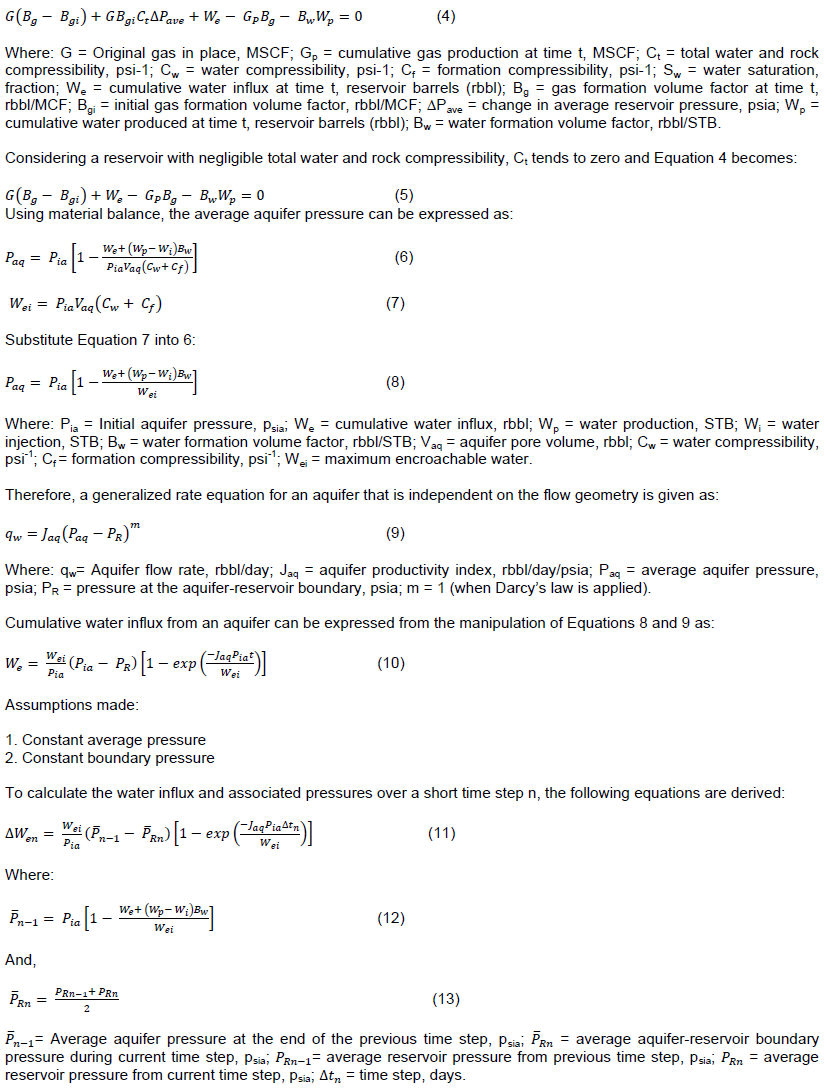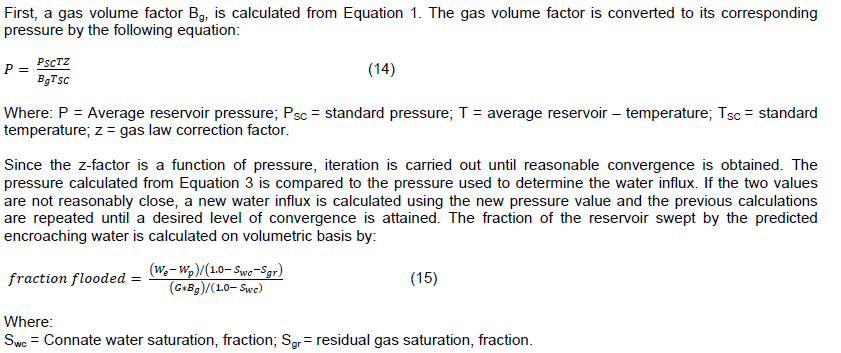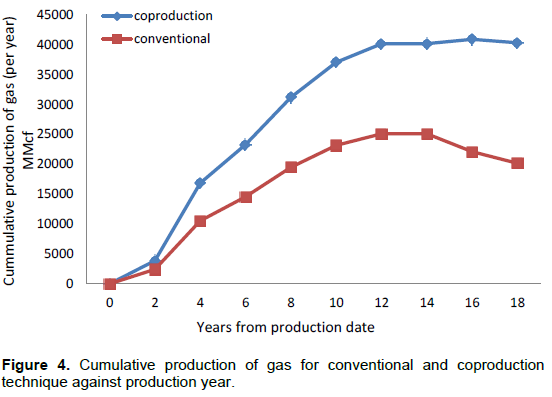ABSTRACT
Recovery factor for gas reservoirs are highly dependent on factors such as initial reservoir pressure, abandonment pressure and the type of reservoir drive mechanism. Producing gas reservoirs with active water drive mechanism possess a lot of challenge to the field operator since optimum production of gas is dependent on reduced pressure. Material balance model was used to derive basic reservoir and production parameters thereafter Excel was used to simulate the parameters for both conventional and co-production scenarios using a field data from the Niger Delta Basin. The reservoir contains three producing wells with conventional technique, while co-production has three wells, producing gas from the up-dip and one well producing water from the down-dip. The simulated results show that gas production rate from the three wells changed with respect to the production strategies. Under conventional, gas production rate from the three wells was at a constant rate of 19MMSCF/D for a long period of time. However, under co-production technique, gas production rate was at a constant rate of 38MMSCF/D for a short period of time. Under conventional method, 231.85BCF of gas was recovered from 356.713BCF of gas initially-in-place with recovery factor of 65% until water cut set-in at an abandonment pressure of 2000 psia. However, under co-production technique, the simulated result shows that there was an optimum recovery of gas of up to 92% recovery which is 27% above the conventional technique and the reservoir pressure was depleted to 1000 psia before water cut set-in.
Key words: Co-production, Niger Delta Basin, gas production, material balance model, gas reservoir.
Gas reservoirs can be classified, according to drive mechanism; depletion-drive or water-drive type. Ultimate recovery from depletion-drive gas reservoirs is limited only by the minimum reservoir pressure, economically possible. Ultimate recovery from water-drive gas reservoirs is governed primarily by physical properties such as the residual gas saturation behind the water front and by the amount of free gas left up-dip above the highest perforation. At abandonment, this gas is generally at a much higher pressure than that experienced in a depletion-drive reservoir. The higher the pressure, the greater the number of SCF of gas lost. The blow-down technique involves increasing gas rate to produce gas before water encroachment. It is an attempt to deplete the reservoir faster than the aquifer can respond resulting in lowering reservoir abandonment pressure.
This method has increased recovery as much as 20-30% when implemented in the field (Brinkman; 1980; Lutes et al., 1976).
However, a reservoir simulation study by Hower et al. (1992) showed that increasing production rate could cause water coning in key production wells. In fact, the simulation model predicted that to increase recovery, the production rate should be lowered rather than accelerated. This anomaly was attributed to improved volumetric sweep efficiency for the lower rate case.
Xiang and Derek (2014), Dai et al. (2014, 2016), Ampomah et al. (2016a, b) have shown in their numerical studies that injection of CO2 in gas reservoirs for enhancing gas recovery is favourable. However, Al-Hashami et al. (2005) investigated the effects of CO2 solubility on formation water during gas recovery; they discovered it does not have any incremental effect on gas recovery. On the contrary, Feather and Acher (2010) were able to carry out a simulation study on enhanced gas recovery and found that high injection flow rate of CO2 into depleted gas reservoir with low permeability and homogenous is very favourable for gas recovery.
This study explores that reservoirs containing only free gas are termed gas reservoirs. If a reservoir contains a mixture of hydrocarbons, which exists wholly in the gaseous state, the mixture may be a dry, wet or condensate gas, depending on the composition of the gas, along with the pressure and temperature at which the accumulation exists.
When we use the term "dry gas", we are referring to a reservoir gas made primarily of methane with some intermediate-weight hydrocarbon molecules. Dry gases do not undergo phase changes following a pressure reduction and therefore no liquids are formed either in the reservoir or production facilities because the path of depletion is completely outside the phase envelope. A wet-gas reservoir is defined as producing a single gas composition to the producing well perforation throughout its life. From a reservoir standpoint, dry and wet gas can be treated similarly in terms of producing characteristics, pressure behaviour and recovery potential.
A volumetric dry gas reservoir is completely enclosed by low-permeability or completely impermeable barriers and does not receive pressure support from external sources, such as an encroaching aquifer. In addition, if the expansion of rock and connate water are negligible, then the primary source of pressure maintenance is gas expansion resulting from gas production and the subsequent pressure reduction.
Dry gas reservoirs with water influx from an aquifer are non-volumetric reservoirs and they are produced under pressure support provided by the encroaching water (Asadullah et al., 2016) and this encroaching water tends to maintain the pressure at higher values depending on the rate at which water encroaches into the reservoir, however, the recovery factors for this type of reservoirs can be significantly lower than that for volumetric reservoirs produced by the simple gas expansion, the reason is that gas is often bypassed and trapped by the encroaching water.
Recovery of reserves such as water-drive reserve should be given more attention than it currently receives due to the increasing price and value of gas. One area requiring further industry attention for enhanced gas recovery is the reservoir associated with an active aquifer. In reservoirs of this type, pressure maintenance and entrapment of gas by encroaching water greatly reduces recovery. Other problems associated with gas recovery from water drive mechanism include; high volume of produced water, abandonment at high reservoir pressures and high possibility of hydrate formation in pipe lines.
With increasing production and pressure drop, water move to pores and throats that is filled with gas and the water displaces the gas incompletely. Although, recovery range from water drive in gas reservoir is wide and low, in simple gas reservoir (without water drive), it is almost fixed near 90%, so, some technique has been used for increasing recovery in gas reservoir. These are blow-down technique and co-production technique. In blow-down technique, higher gas production rates are relied upon to outrun the aquifer advance. Pressure in the gas zone is reduced before the aquifer response is felt. The blow-down technique is limited to systems with a relatively weak water influx (Lee and Wattenbarger, 2002). However, in co-production technique, as the down-dip wells begin to water out, they are converted to high-rate water producers, while the up-dip gas wells maintain gas production. If enough water is produced, the water influx can be halted or at least slowed down, allowing up-dip wells to deplete the free gas zone to lower pressure. Also, bypassed gas may regain mobility as pressure is lowered in the water-swept zone. However, this research aimed to review the possible methods that can be applied to improve recovery in water drive reservoir, to show general procedure for evaluating the viability of co-production using material balance model, and carry out sensitivity analysis to illustrate the effect(s) of aquifer influx on reservoir pressure in water-drive reservoir.
Conventional and co-production techniques production strategies were used for evaluation and optimization of gas recovery from the Water Drive Gas Reservoir. The two techniques for gas recovery optimization (as stated above) were constructed using experimental cases (Table 1) based on the assumptions that for conventional technique, production rate was low- not more than 19 MMSCF/D per well. Production was taken from three wells in the gas zone only, production time continued until all gas wells were shut due to high water cut, depletion of pressure was slower, due to low rate of production and more production time. However, for co-production technique, accelerated production rates were relied on. Production rate twice the conventional restricted approach was considered. A maximum gas production rate of 38 MMSCF/D per well was carried out. There is a water-well in the aquifer zone that produces at 20,000 STB/d, gas production was taken from 3 (three) wells, which are produced from the gas zone only. Simultaneously, water production was carried out in order to deplete the reservoir pressure and retard the aquifer advance, production time continued until all gas wells were shut due to lower limit of tubing head pressure which is set at 500 psi. Depletion of pressure was faster, due to accelerated production rate of water and moderate production time, and there was a water disposal well available.

.png)
Material Balance Model was used to derive qmax, WP and and after which, a simulation and sensitivity analysis was carried out using excel to determine how much greater Wp should be than qmax for efficient and cost effective production, if Wp should be given one working value for the entire productive lifespan of the reservoir or be decreased/increased over time, if Wp should be varied, by what factor? At what time during production should co-production technique be introduced? Since the desired result show continuous decline in reservoir pressure. Applying material balance model,
Remaining = Initial – production + change in HCPV (1)
Where: G = Original gas in place, MSCF; Gp = cumulative gas production at time t, MSCF; Ct = total water and rock compressibility, psi-1; Cw = water compressibility, psi-1; Cf = formation compressibility, psi-1; Sw = water saturation, fraction; We = cumulative water influx at time t, reservoir barrels (rbbl); Bg = gas formation volume factor at time t, rbbl/MCF; Bgi = initial gas formation volume factor, rbbl/MCF; ∆Pave = change in average reservoir pressure, psia; Wp = cumulative water produced at time t, reservoir barrels (rbbl); Bw = water formation volume factor, rbbl/STB.
Considering a reservoir with negligible total water and rock compressibility, Ct tends to zero and Equation 4 becomes:
First, a gas volume factor Bg, is calculated from Equation 1. The gas volume factor is converted to its corresponding pressure by the following equation:
Reservoir data (Table 2) from a reservoir with three wells, located in the Niger Delta Basin of Nigeria was used to test the model. The reservoir is supported with edge water drive (which is active). Three wells (F-1, F-2 and F-3) have 4.5 inch OD.

The gas production rate of all three wells (F-1, F-2 and F-3) changed with respect to the production strategies. Gas production rate from well F-1, F-2 and F-3 was at constant rate of 19 MMSCF/D for a longer period of time under conventional technique while for co-production, gas production rate was at constant rate of 38 MMSCF/D for a shorter period of time (Figure 1). As certain time elapsed, the pressure drop became faster as the change rate became greater due to depletion/production rate. Production under co-production deviated in the three producing gas wells from that of blow-down. This may be logical when response of aquifer is observed and the water breakthrough in gas wells, which was produced with rapid change as the wells were shut in blow-down technique. But, in the case of co-production technique, the wells were produced at the same time due to drainage of huge amounts of water from the bottom using well F-4. No production of gas was seen from well F-4 throughout the whole life of the well as this well was drilled in the water zone (down dip of the reservoir).
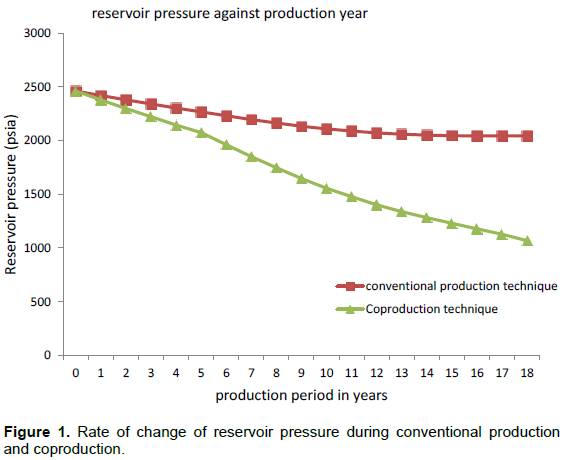
Under the conventional technique, 231.85BCF of gas was produced out of a total of 356.7 BCF of gas initially in place, that is, recovery factor of 65%. At abandonment, the reservoir pressure was 2,000 psia and there was water cut. However, under co-production technique, the recovery factor was improved up to 92% (Figure 2) because of accelerated production of water concurrently with gas from the reservoir. Hence, the reservoir was able to be depleted down to abandonment pressure of 1,000 psia (Figure 1). Depletion in reservoir pressure resulted in the optimum recovery, 92% recovery which is 27% above the conventional method. Co-production improved the recovery in all study cases where it was applied. However in cases with an extremely strong water-drive, unreasonably high water production rates would be needed to halt the aquifer. Reasonable water production rates showed an increase in recovery but the incremental returns could not economically justify co-production.

Intuitively, the more the water produced, the better the recovery. The model has indicated, however, that in some cases, higher water production rates did not further enhance recovery. Figure 2 shows that the recovery steadily increases as production rates of water increase up to 15,000 BPD. Beyond that rate, the reservoir pressure reached the chosen limiting value of 1,000 psia much faster with no additional recovery. Technically, it is always best to start co-production early, but it may have to be delayed until later in the reservoir's life for economic reasons. However, the longer the co-production is postponed, the higher the daily water production needed to reach a certain recovery level. Such high production rate might not be possible. After the first year, the rate of water influx is 1,900BPD; however, by the end of the second year, the aquifer flow rate is over 3,200BPD(Figure 3).
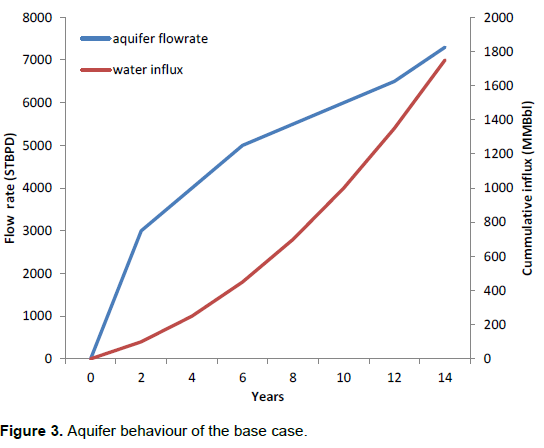
The optimum co-production rate is higher than the aquifer rate because 126 MMbbl of water have already invaded the reservoir. In this way, the aquifer has a head start and we have to “catch up” to it. As gas production decreases the reservoir pressure, the rate of water influx continues to climb. By the fifth year, 425 MMbbl of influx have occurred and the aquifer flow rate was 4,900 BPD. At this point, the optimum co-production rate was nearly twice the influx rate. The interesting part is that the reservoir pressure began to decline slowly after year 5, which means the influx rate increases more slowly. Even though there is only one third of the way through the life of the reservoir, recovery optimization was less and lesser possible due to increasing water production rates.
Introduction of co-production technique at the start of the production year improved the recovery of gas in this study (Figure 4). It resulted to higher cumulative production than that of conventional production technique as shown in Figure 4. Co-production technique reduced the reservoir pressure and hydrocarbon (HCPV) pore volume at abandonment; thus, truly optimized the gas recovery from the reservoir.
Water production well can help in rapid de pressurization of the reservoir to recover maximum trapped gas. The timing and location of the water production well and water production rate need to be designed carefully.
The co-production technique presents a viable technical method of enhancing gas recovery from water-drive gas reservoirs. This is especially true in cases where the water-drive index exceeds 35%. The earlier co-production is implemented, the higher the recovery. The feasibility of the co-production technique in an actual case is demonstrated by the technical analyses of reservoir-A in the Niger delta basin of Nigeria. The predicted recovery for the co-production case is 92% when compared with only 65% for the conventional production technique which represents an increase of 96.31 BCF.
The satisfactory selection of production strategy plays a crucial role in the optimization of gas recovery and reserves. The drilling of additional wells for water production will result in an optimized gas production. The co-production strategy provides better results as compared to conventional techniques in terms of produced maximum gas rate, incremental reserves and the techno-economic factors.
Pertinent measures should be taken according to the actual situation of gas reservoirs to determine the viability of applying co-production technique to the reservoir. Early-phase prediction, accurate judgment, timely treatment, gas-water relationship description, analysis of water influx dynamics, optimization of gas production through water drainage, processing of formation water and economic evaluation, are the key factors to guaranteeing the good effect of water control (that is, co-production technique) in gas reservoirs.
The economic analysis shows the co-production technique is a very attractive option for producing this reservoir. Co-production is undoubtedly feasible in many other water-drive index screening criteria. An economic study of each possible reservoir should be carried out to determine its profitability.
The authors declare that there is no conflict of interest.
REFERENCES
|
Asadullah M, Faisal-Ur-Rahaman A, Zeeshan AL, Hafeez-Ur-Rahaman M, Bilal SM (2016). A Case Study of the Production Strategies of Four Wells for Optimizing the Gas Recovery from Water Drive Dry Gas Reservoir. Austr. J. Eng. Technol. Res. 1(2):14-23.
|
|
|
|
Al-Hashami A, Ren SR, Tohidi B (2005). C02 Injection for Enhanced Gas Recovery and Geo-Storage: Reservoir Simulation and Economics, in proceedings of SPE Europe/EAGE annual conference SPE 94129.
|
|
|
|
|
Ampomah W, Balch R, Cather M, Rose-Coss D, Dai Z, Heath J, Dewers T, Mozley P (2016a). Evaluation of CO2 Storage Mechanisms in CO2 Enhanced Oil Recovery Sites: Application to Morrow Sandstone Reservoir. Energy Fuels 30(10):8545-855.
Crossref
|
|
|
|
|
Ampomah W, RS Balch RB, Grigg R, Will SY, Lee Z (2016b). Performance of CO2-EOR and Storage Processes under Uncertainty, SPE-180084-MS, Soc. Petroleum Eng. 2016.
|
|
|
|
|
Brinkman FP (1980). Increased Gas Recovery from a Moderate Water Drive Reservoir SPE 9473 presented at the 55th Annual SPE Fall Technical Conference held in Dallas, TX.
|
|
|
|
|
Dai Z, Middleton R, Viswanathan H, Fessenden-Rahn J, Bauman J, Pawar R, Lee S, McPherson B (2014). An integrated framework for optimizing CO2 sequestration and enhanced oil recovery. Environ. Sci. Technol. Lett. 1:49-54.
Crossref
|
|
|
|
|
Dai ZH, Viswanathan R, Middleton F, Pan W, Ampomah C, Yang W, Jia T, Xiao S, Lee B, McPherson R, Balch R, Grigg M (2016). White, CO2 Accounting and Risk Analysis for CO2 Sequestration at Enhanced Oil Recovery Sites. Environ. Sci. Technol. 50:7546-7554.
Crossref
|
|
|
|
|
Feather B, Archer RA (2010). Enhanced Natural Gas Recovery by carbon dioxide injection for storage purposes. 17th Australasian Fluid Mechanics conference, Auckland, Newzeland.
|
|
|
|
|
Hower TL, Lewis DR, Owens RW (1992). Recovery Optimization in a Multi-Reservoir Offshore Gas Field with Water Influx SPE 24865 presented at the SPE Annual Technical Conference held in Washington D.C., October 4-7, 1992.
|
|
|
|
|
Lee J, Wattenbarger RA (2002). Gas Reservoir Engineering SPE Texbook Series, Second Printing, Society of Petroleum Engineers, Richardson, Texas.
|
|
|
|
|
Lutes JL, Chiang CP, Rossen RH, Brady MM (1976). Accelerated Blow-Down of a Strong Water Drive Gas Reservoir. SPE 6166 presented at the SPE AIME 51st Annual Fall Technical Conference and Exhibition, he1d in New Orleans, LA.
|
|
|
|
|
Xiang L, Derek E (2014). Geomechanics of C02 Enhance Shale Gas Recovery. J. Nat.l Gas Sci. Eng. 1-13.
|
|

.png)
